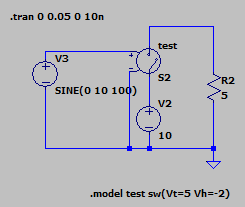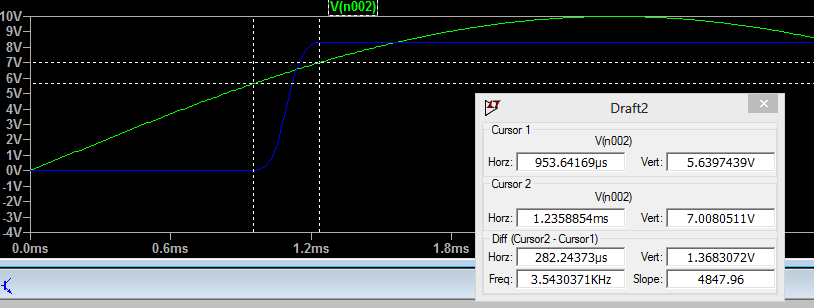Try to not judge "visually", because you can get deceived. In this case, the time when the VCSW starts conducting is (according to the manual, LTspice > Circuit Elements > S. ...):
If Vh is negative, the switch will smoothly transition between the on and off impedances. The transition occurs between the control voltages of Vt - Vh and Vt + Vh.
Therefore, given your settings, the conduction occurs between 3 V and 7 V. If you can't determine this visually it's because the defaults are Ron=1 and Roff=1/Gmin=1e12, and the midpoint is \$\sqrt{R_{on}R_{off}}\$, and the smaller values simply get buried in pixels. The resistance is, also according to the manual:
The smooth transition follows a low order polynomial fit to the logarithm of the switch's conduction.
If you're really interested in details, the exact formula is:
$$\begin{align}
R&=\exp{\left[R_{ls}-3R_{lr}\left(\dfrac{V_{ctl}-V_T}{4V_H}\right)+2R_{lr}\left(\dfrac{V_{ctl}-V_T}{2V_H}\right)^3\right]} \tag{1} \\
R_{ls}&=\log{\sqrt{R_{on}R_{off}}} \\
R_{lr}&=\log{\left(\dfrac{R_{off}}{R_{on}}\right)}
\end{align}$$
This is for level=1, and you can also find it if you search for PSPCREF.PDF on the web (it's the manual for PSpice, it should be freely available). For level=2, the formula is described in LTspice's manual (same page).
Here's a test jig (and confirmation) for the above:

Don't forget that part of the confusion is the driving voltage for your schematic: a sine, versus a linear ramp, like in my example.




